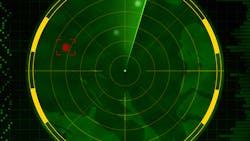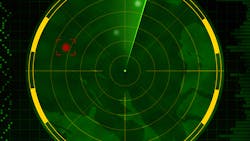In case you didn’t know, you are living in the age of the single-chip radar. These chips are now widely used in automobiles, so volume is increasing—thereby reducing the price. This makes them ever more practical for other applications, which got me to thinking: What are these other apps? Here are a few thoughts.
The single-chip radars come in a variety of forms. You can get them in the 24, 60, 76-77, and 94 GHz bands. Some research-lab chips operate at 120 GHz. As for modulation, there are CW and pulse types—but most seem to use FM-CW. There are even some impulse UWB units available. Maximum range is about 10 to 60 meters. Most are made with SiGe, but there are some CMOS devices emerging. Prices are still in the high single digits, but coming down. A number of companies offer complete modules, especially for auto use.
What radar traditionally does is measure distance, direction, and speed. And the new single-chip devices are no exception. However, one good way to look at these chips is as sensors. They can still measure distance and speed, but they also indicate presence or motion. For example, one popular use is a liquid level sensor in a tank.
Single-chip radar’s greatest success so far is its use for automotive safety and convenience. Some examples are adaptive cruise control, collision mitigation with automatic braking, lane-departure sensing, and even backup object detection. While most of these accessories are primarily found in high-end cars, they are showing up more and more in mid-range and low-priced cars. They are so effective that I half suspect the government will soon mandate all cars have them—not a bad idea. And, of course, single-chip radar is absolutely essential to the success of the driverless car.
So what else can you do with a single chip radar? One approach is to use the “find a need and fill it” method of product development. But another approach is one engineers love: Here is a cool, new chip, what new product can I make with it? Marketability and need are secondary factors. Here are my thoughts on this.
1. Drone safety. Use the chips as a cheap altimeter to ensure meeting the 400-foot ceiling now imposed by the FAA. Or why not use the chips to prevent drone collisions with one another or other objects? This could be one way that the FAA will eventually bless commercial drones.
2. Automatic door openers. How about a garage door opener that senses when your car gets close and opens automatically? This would also be good for gates. No button to push. But what if a moose walks in front of your garage door and it opens? Uh oh, back to the drawing board.
3. Bug zapper. Maybe it is possible to make a radar that tracks flies, mosquitoes, or other nuisance bugs and vaporizes them with a low-power laser. A great new consumer product for use on picnic tables or in the backyard. But then will everyone need to wear eye protection or other safety devices or risk getting zapped by the laser? Oooops….
4. Security. Security is a major need and app these days. Video cameras are everywhere. But sometimes all you need is a presence sensor or motion detector to set off an alarm. IR is used for this now, but radar would increase the range. A related need is to sense the presence or movement of animals.
5. Bicycle safety. If radar is so effective with automobiles, maybe it should be used on bikes—where personal safety is always an issue. This could cut deaths and accidents significantly if implemented correctly. Maybe the radar would be a wearable on a helmet or on the body like in a vest. The prices are right at last.
Single-chip radars are also perfect for robots, and I suspect someone will invent a toy using radar. But you tell me: What would you do with a single-chip radar?
About the Author
Lou Frenzel
Technical Contributing Editor
Lou Frenzel is the Communications Technology Editor for Electronic Design Magazine where he writes articles, columns, blogs, technology reports, and online material on the wireless, communications and networking sectors. Lou has been with the magazine since 2005 and is also editor for Mobile Dev & Design online magazine.
Formerly, Lou was professor and department head at Austin Community College where he taught electronics for 5 years and occasionally teaches an Adjunct Professor. Lou has 25+ years experience in the electronics industry. He held VP positions at Heathkit and McGraw Hill. He holds a bachelor’s degree from the University of Houston and a master’s degree from the University of Maryland. He is author of 20 books on computer and electronic subjects.
Lou Frenzel was born in Galveston, Texas and currently lives with his wife Joan in Austin, Texas. He is a long-time amateur radio operator (W5LEF).

